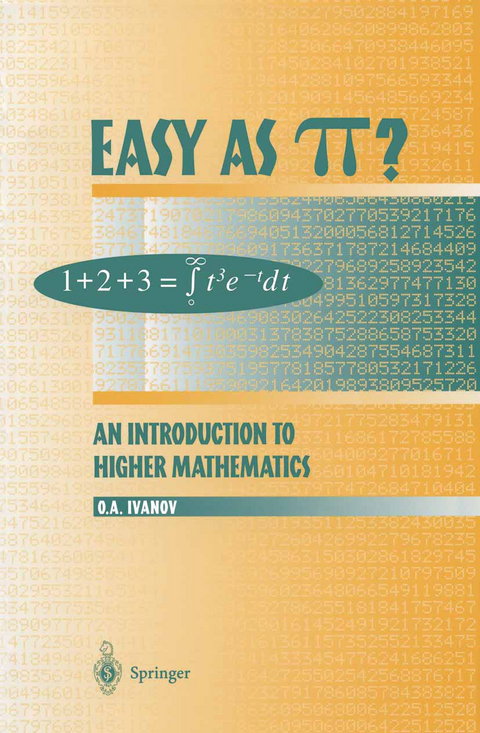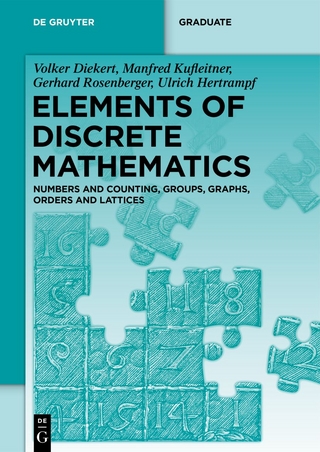Easy as π?
Springer-Verlag New York Inc.
978-0-387-98521-3 (ISBN)
The present book is rare, even unique of its kind, at least among mathematics texts published in Russian. You have before you neither a textbook nor a monograph, although these selected chapters from elementary mathematics certainly constitute a fine educational tool. It is my opinion that this is more than just another book about mathematics and the art of teaching that subject. Without considering the actual topics treated (the author himself has described these in sufficient detail in of the book as a whole, the Introduction), I shall attempt to convey a general idea and describe the impressions it makes on the reader. Almost every chapter begins by considering well-known problems of elementary mathematics. Now, every worthwhile elementary problem has hidden behind its diverting formulation what might be called "higher mathematics," or, more simply, mathematics, and it is this that the author demonstrates to the reader in this book. It is thus to be expected that every chapter should contain subject matter that is far from elementary. The end result of reading the book is that the material treated has become for the reader "three-dimensional" as it were, as in a hologram, capable of being viewed from all sides.
1 Induction.- 1.1 Principle or method?.- 1.2 The set of integers.- 1.3 Peano’s axioms.- 1.4 Addition, order, and multiplication.- 1.5 The method of mathematical induction.- 2 Combinatorics.- 2.1 Elementary problems.- 2.2 Combinations and recurrence relations.- 2.3 Recurrence relations and power series.- 2.4 Generating functions.- 2.5 The numbers ?e, and n-factorial.- 3 Geometric Transformations.- 3.1 Translations, rotations, and other symmetries, in the context of problem-solving.- 3.2 Problems involving composition of transformations.- 3.3 The group of Euclidean motions of the plane.- 3.4 Ornaments.- 3.5 Mosaics and discrete groups of motions.- 4 Inequalities.- 4.1 The means of a pair of numbers.- 4.2 Cauchy’s inequality and the a.m.-g.m. inequality.- 4.3 Classical inequalities and geometry.- 4.4 Integral variants of the classical inequalities.- 4.5 Wirtinger’s inequality and the isoperimetric problem.- 5 Sets, Equations, and Polynomials.- 5.1 Figures and their equations.- 5.2 Pythagorean triples and Fermat’s last theorem.- 5.3 Numbers and polynomials.- 5.4 Symmetric polynomials.- 5.5 Discriminants and resultants.- 5.6 The method of elimination and Bézout’s theorem.- 5.7 The factor theorem and finite fields.- 6 Graphs.- 6.1 Graphical reformulations.- 6.2 Graphs and parity.- 6.3 Trees.- 6.4 Euler’s formula and the Euler characteristic.- 6.5 The Jordan curve theorem.- 6.6 Pairings.- 6.7 Eulerian graphs and a little more.- 7 The Pigeonhole Principle.- 7.1 Pigeonholes and pigeons.- 7.2 Poincaré’s recurrence theorem.- 7.3 Liouville’s theorem.- 7.4 Minkowski’s lemma.- 7.5 Sums of two squares.- 7.6 Sums of four squares. Euler’s identity.- 8 The Quaternions.- 8.1 The skew-field of quaternions, and Euler’s identity.- 8.2 Division algebras. Frobenius’stheorem.- 8.3 Matrix algebras.- 8.4 Quaternions and rotations.- 9 The Derivative.- 9.1 Geometry and mechanics.- 9.2 Functional equations.- 9.3 The motion of a point—particle.- 9.4 On the number e.- 9.5 Contracting maps.- 9.6 Linearization.- 9.7 The Morse-Sard theorem.- 9.8 The law of conservation of energy.- 9.9 Small oscillations.- 10 The Foundations of Analysis.- 10.1 The rational and real number fields.- 10.2 Nonstandard number lines.- 10.3 “Nonstandard” statements and proofs.- 10.4 The reals numbers via Dedekind cuts.- 10.5 Construction of the reals via Cauchy sequences.- 10.6 Construction of a model of a nonstandard real line.- 10.7 Norms on the rationals.- References.
| Übersetzer | R. G. Burns |
|---|---|
| Zusatzinfo | 1 Illustrations, black and white; XVIII, 190 p. 1 illus. |
| Verlagsort | New York, NY |
| Sprache | englisch |
| Maße | 155 x 235 mm |
| Themenwelt | Mathematik / Informatik ► Mathematik ► Graphentheorie |
| Mathematik / Informatik ► Mathematik ► Wahrscheinlichkeit / Kombinatorik | |
| ISBN-10 | 0-387-98521-2 / 0387985212 |
| ISBN-13 | 978-0-387-98521-3 / 9780387985213 |
| Zustand | Neuware |
| Haben Sie eine Frage zum Produkt? |
aus dem Bereich


